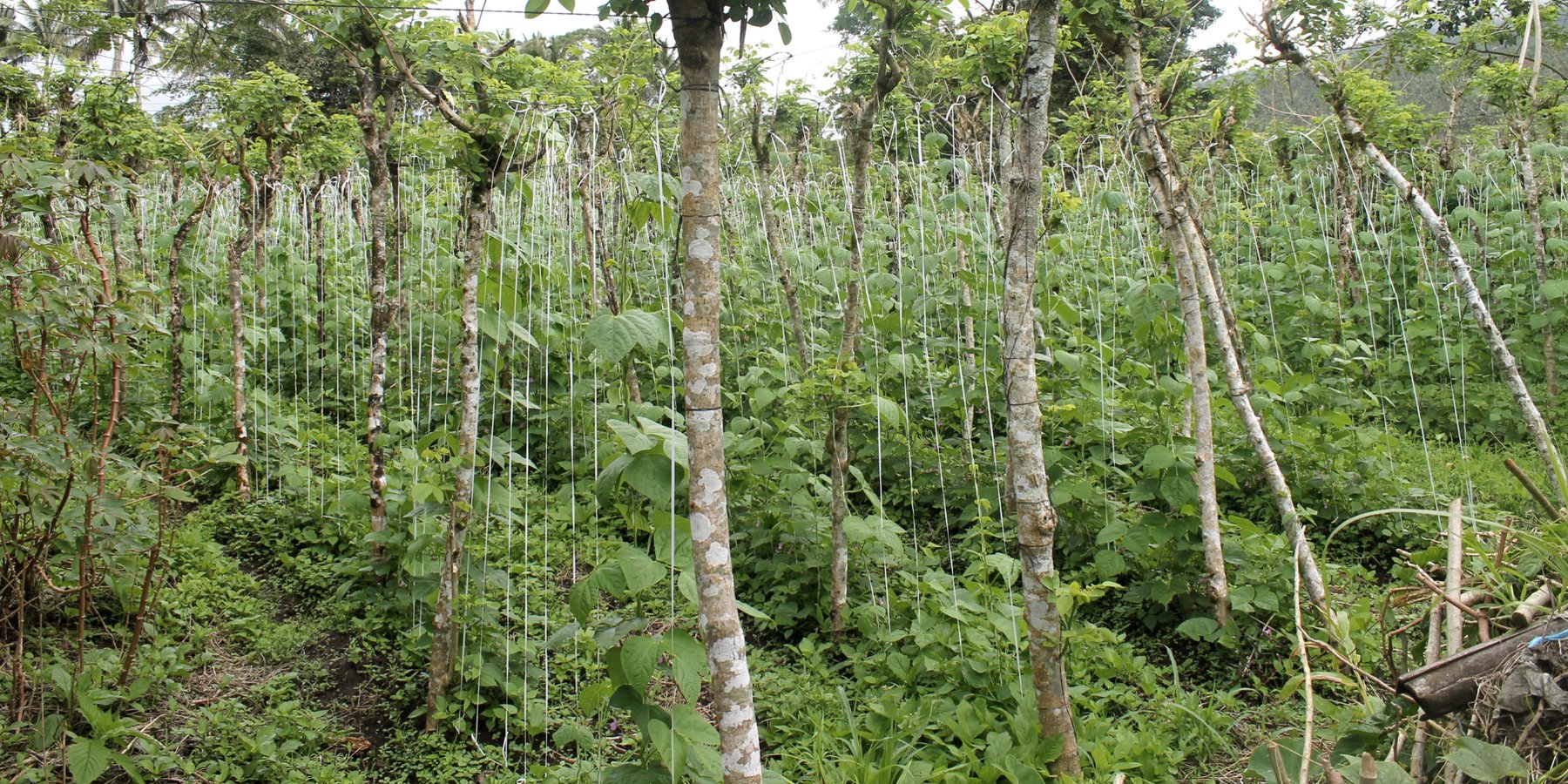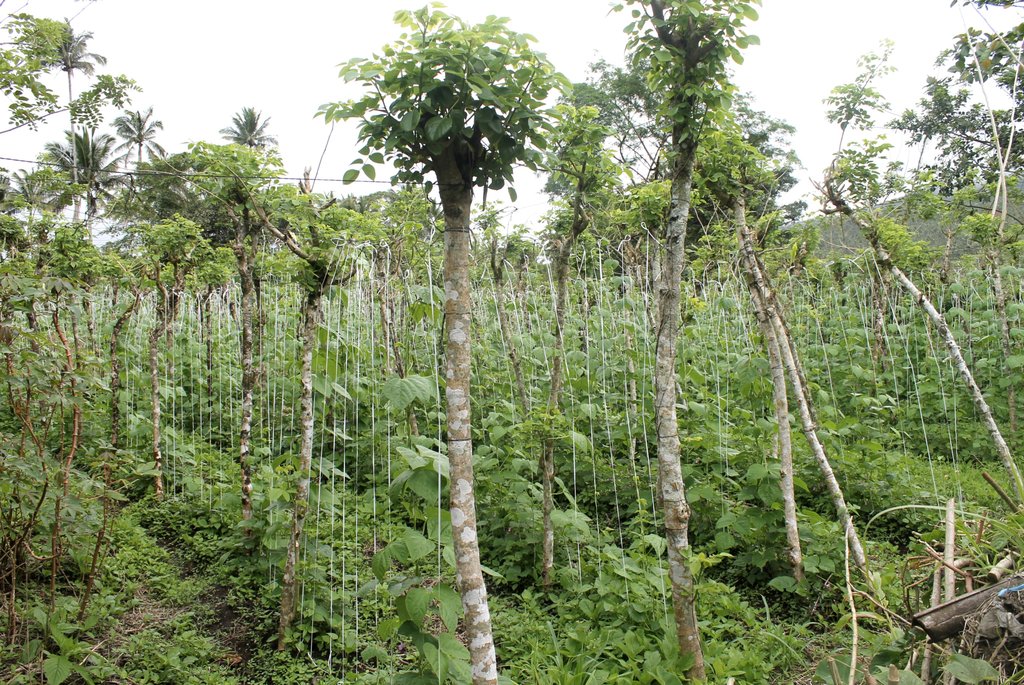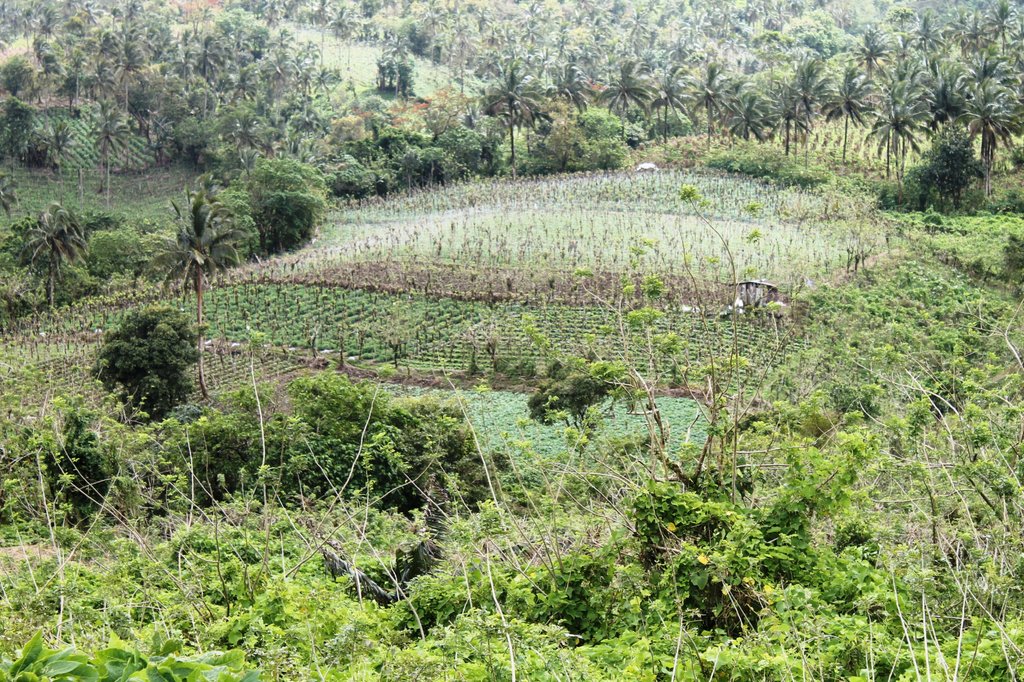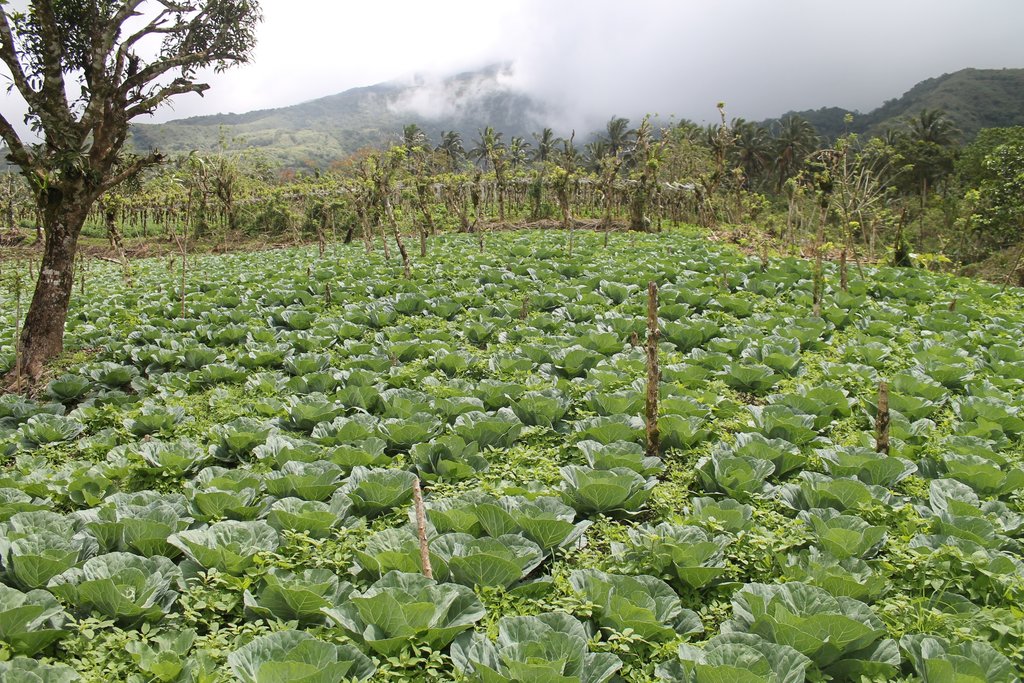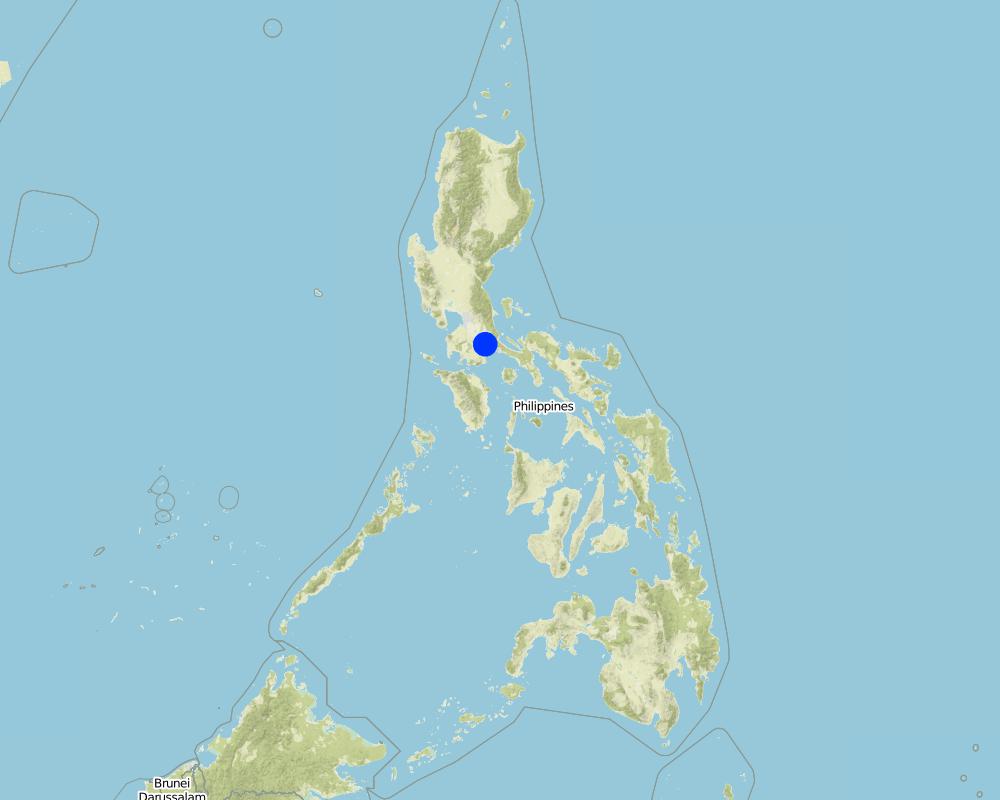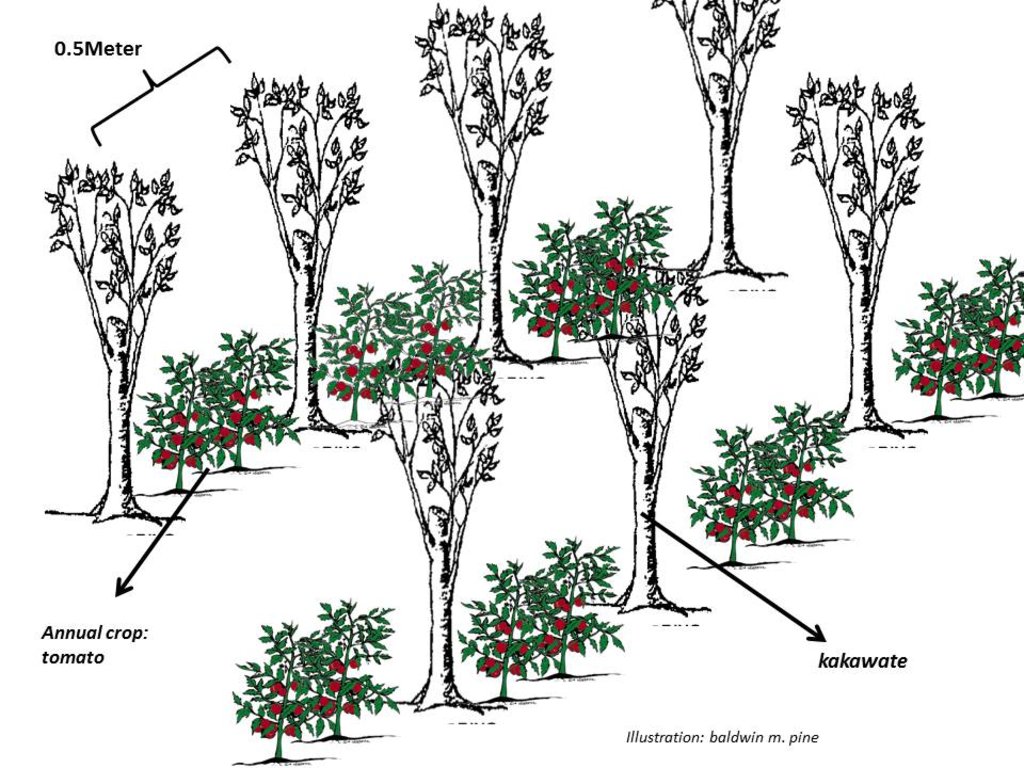Highly Diversified Cropping in Live Trellis System [Philippines]
- Creation:
- Update:
- Compiler: Philippine Overview of Conservation Approaches and Technologies
- Editor: –
- Reviewers: Ursula Gaemperli, Alexandra Gavilano
Kakawate as live trellis "balag"
technologies_1930 - Philippines
View sections
Expand all Collapse all1. General information
1.2 Contact details of resource persons and institutions involved in the assessment and documentation of the Technology
Key resource person(s)
land user:
Urriza Girlie
Philippines
SLM specialist:
Dela Pena Calixto
Local Government of Nagcarlan, Laguna
Philippines
Soil Specialist / GIS Specialist:
Pine Baldwin
Bureau of Soils and Water Management
Philippines
Engineer:
Raquid Jemar
Bureau of Soils and Water Management
Philippines
Engineer:
Torino Mharicar
Bureau of Soils and Water Management
Philippines
Engineer:
Tayao Aries
Bureau of Soils and Water Management
Philippines
Name of project which facilitated the documentation/ evaluation of the Technology (if relevant)
Decision Support for Mainstreaming and Scaling out Sustainable Land Management (GEF-FAO / DS-SLM)Name of the institution(s) which facilitated the documentation/ evaluation of the Technology (if relevant)
Bureau of Soils and Water Management (Bureau of Soils and Water Management) - Philippines1.3 Conditions regarding the use of data documented through WOCAT
The compiler and key resource person(s) accept the conditions regarding the use of data documented through WOCAT:
Yes
1.4 Declaration on sustainability of the described Technology
Is the Technology described here problematic with regard to land degradation, so that it cannot be declared a sustainable land management technology?
No
2. Description of the SLM Technology
2.1 Short description of the Technology
Definition of the Technology:
Gliricidia sepium locally known as "kakawate" served as live trellis / or anchorage for annual crops (mostly creeping-type vegetables) and erosion control measure. The technology is well-adopted in the community providing immediate food for the farmers and increased income due to diversified farming.
2.2 Detailed description of the Technology
Description:
The Highly Diversified Cropping in Live Trellis System is a traditional or local farmers' initiative technology widely practiced in Brgy. Bukal, Nagcarlan, Laguna situated in the area of Mt. Banahaw. The area with rolling to hilly terrain is receiving an annual rainfall of 1000-2000 mm. Each of the farmers who practiced the technology has 0.5 to 1.0 ha production area. Moreover, the community is accessible to infrastructures such as schools and market. Soils in the area is relatively good for agriculture cultivation.
Kakawate, a small to medium-sized, thornless tree which usually attains a height of 10-12 m is being used as live trellis or "balag" to various annual crops such as tomato, cucumber, chayote, beans, and ampalaya in the community. The cropping system is highly diversified since crop rotation is being practiced throughout the year. Aside from being an anchorage for annual crops, kakawate also stabilizes sloping lands and reduces soil erosion due to its strong roots which can grow 3-5 meters laterally, thereby holding the soil firmly. They are planted in a row of approximately 2-3 meters making it more effective in preventing soil erosion. Furthermore, kakawate is being trimmed and maintained every 3-6 months or as needs arise to a approximate 3 meters high as live trellis, the trimmed leaves are very rich in nitrogen and will eventually serve as compost or crop cover. These will help in improving soil quality and moisture in the soil. In addition, kakawate has multiple uses and benefits; they can serve as hardwood or firewood when matured, as materials in making furniture and anchorage for flowering plants like orchids.
In establishing the live trellis system, kakawate trunks/or cuttings "quick sticks" with at least 2-meter height are planted in a row. An estimate of 0.5 to 1 meter planting distance within a row and also between rows is used. When the kakawate trunks are already set up and planted, they are interconnected using a metallic wires. Along these wires, plastic straws are tied in a vertical position whereby crops can utilize this straws for creeping/ climbing . Finally, the desired crop will be planted according to their cropping pattern. Maintenance of the technology includes: weeding and trimming. During infestation, application of pesticide is done but in minimal.
The technology requires manual works resulting to elimination of machines that contributes to soil compaction.
The technology has been a practice in the community for a long time, and land users continue to adopt the technology because of it's easiness and inexpensiveness to establish, and low cost in terms of maintenance activity. Adding up to this is the variety of plants to be grown, making their market more profitable.
Gliricidia normally grows in tropical countries like the Philippines and is being utilized as hedgerows for erosion control measures. Over the years, its effectiveness as erosion control is known, and an increasingly used forage crop in cut-and-carry systems.
2.3 Photos of the Technology
2.5 Country/ region/ locations where the Technology has been applied and which are covered by this assessment
Country:
Philippines
Region/ State/ Province:
Laguna
Further specification of location:
Brgy. Bukal, Nagcarlan
Specify the spread of the Technology:
- evenly spread over an area
If precise area is not known, indicate approximate area covered:
- 1-10 km2
Comments:
Most of the farmers in the community adopt the technology
Map
×2.6 Date of implementation
Indicate year of implementation:
1950
If precise year is not known, indicate approximate date:
- more than 50 years ago (traditional)
2.7 Introduction of the Technology
Specify how the Technology was introduced:
- through land users' innovation
- as part of a traditional system (> 50 years)
3. Classification of the SLM Technology
3.1 Main purpose(s) of the Technology
- improve production
- reduce, prevent, restore land degradation
- conserve ecosystem
- protect a watershed/ downstream areas – in combination with other Technologies
- preserve/ improve biodiversity
- reduce risk of disasters
- adapt to climate change/ extremes and its impacts
- create beneficial economic impact
- create beneficial social impact
3.2 Current land use type(s) where the Technology is applied

Cropland
- Annual cropping
- Tree and shrub cropping
Annual cropping - Specify crops:
- legumes and pulses - beans
- vegetables - leafy vegetables (salads, cabbage, spinach, other)
- tomatoes
- Sayote (cf. Cucurbitaceae family), Kakawate (cf. Gliricidia sepium)
Number of growing seasons per year:
- 3
Specify:
Cabbages and lettuce can be harvested three times a year.
Comments:
Main crops (cash and food crops): Sayote, beans, tomato, cabbage, lettuce, Kakawate
3.4 Water supply
Water supply for the land on which the Technology is applied:
- rainfed
3.5 SLM group to which the Technology belongs
- agroforestry
- improved ground/ vegetation cover
- integrated soil fertility management
3.6 SLM measures comprising the Technology

agronomic measures
- A1: Vegetation/ soil cover
- A2: Organic matter/ soil fertility
- A3: Soil surface treatment

vegetative measures
- V1: Tree and shrub cover
3.7 Main types of land degradation addressed by the Technology

soil erosion by water
- Wt: loss of topsoil/ surface erosion
- Wo: offsite degradation effects
3.8 Prevention, reduction, or restoration of land degradation
Specify the goal of the Technology with regard to land degradation:
- prevent land degradation
- reduce land degradation
4. Technical specifications, implementation activities, inputs, and costs
4.1 Technical drawing of the Technology
Technical specifications (related to technical drawing):
Kakawate cuttings are planted with an estimated planting distance of 0.5 m to 1 m. They are trimmed and maintained at around 3 meters high for every 3-6 months or as needs arise. In between the kakawate are annual crops like tomato, chayote, beans,cucumber, lettuce and cabbages which are planted in rotation depending on the season.
Author:
Baldwin M. Pine
Date:
03/03/2017
4.2 General information regarding the calculation of inputs and costs
Specify how costs and inputs were calculated:
- per Technology area
Indicate size and area unit:
0.5 hectare
other/ national currency (specify):
Philippine Peso (Php)
If relevant, indicate exchange rate from USD to local currency (e.g. 1 USD = 79.9 Brazilian Real): 1 USD =:
50.0
Indicate average wage cost of hired labour per day:
300
4.3 Establishment activities
| Activity | Timing (season) | |
|---|---|---|
| 1. | Clearing of the area | As needs arise or before planting of kakawate and annual crops |
| 2. | Planting of kakawate cuttings | |
| 3. | Installation of metal wire and plastic straws | |
| 4. | Planting of annual crop: tomato | First cropping usually from December to March |
| 5. | Planting of annual crop: cucumber or beans | After harvest of the 1st crop (tomato) usually from April to June |
| 6. | Planting of annual crop: chayote | After harvest of the second crop ( cucumber or beans) usually from July to December |
4.4 Costs and inputs needed for establishment
| Specify input | Unit | Quantity | Costs per Unit | Total costs per input | % of costs borne by land users | |
|---|---|---|---|---|---|---|
| Labour | Manual labour: Weeding | person-days | 3.0 | 300.0 | 900.0 | 100.0 |
| Labour | Manual labour: Planting | person-days | 3.0 | 300.0 | 900.0 | 100.0 |
| Labour | Manual labour: Fertilizer Application | person-days | 3.0 | 300.0 | 900.0 | 100.0 |
| Labour | Manual labour: Harvesting and Hauling | person-days | 3.0 | 300.0 | 900.0 | 100.0 |
| Plant material | Kakawate cuttings (cuttings are abundant in the area and not for sale) | 100.0 | ||||
| Plant material | Tomato @ 100grams per can | can | 1.0 | 1950.0 | 1950.0 | 100.0 |
| Plant material | Cucumber @ 100grams per can | can | 1.0 | 600.0 | 600.0 | 100.0 |
| Plant material | Chayote (seeds are abundant in the area) | 100.0 | ||||
| Fertilizers and biocides | Inorganic fertilizer: Urea | bag | 5.0 | 1500.0 | 7500.0 | 100.0 |
| Fertilizers and biocides | Organic fertilizer: chicken dung | bag | 5.0 | 450.0 | 2250.0 | 100.0 |
| Fertilizers and biocides | Pesticide | bottle | 1.0 | 280.0 | 280.0 | 100.0 |
| Construction material | Metal wire ( can be used for a long time, up to 10 years life span | roll | 6.0 | 480.0 | 2880.0 | 100.0 |
| Construction material | Straw | roll | 10.0 | 100.0 | 1000.0 | 100.0 |
| Total costs for establishment of the Technology | 20060.0 | |||||
| Total costs for establishment of the Technology in USD | 401.2 | |||||
4.5 Maintenance/ recurrent activities
| Activity | Timing/ frequency | |
|---|---|---|
| 1. | Weeding | As needs arise but normally twice per cropping per crop |
| 2. | Trimming of kakawate | As needs arise |
| 3. | Application of organic fertilizer | Once per cropping |
| 4. | Application of inorganic fertilizer | Twice per cropping |
| 5. | Spraying of pesticide | As needs arise |
4.6 Costs and inputs needed for maintenance/ recurrent activities (per year)
| Specify input | Unit | Quantity | Costs per Unit | Total costs per input | % of costs borne by land users | |
|---|---|---|---|---|---|---|
| Labour | Weeding | person-days | 3.0 | 300.0 | 900.0 | 100.0 |
| Labour | Trimming of kakawate | person-days | 3.0 | 300.0 | 900.0 | 100.0 |
| Labour | Application of organic fertilizer | person-days | 3.0 | 300.0 | 900.0 | 100.0 |
| Labour | Application of inorganic fertilizer | person-days | 3.0 | 300.0 | 900.0 | 100.0 |
| Equipment | Spraying of pesticide | person-days | 3.0 | 300.0 | 900.0 | 100.0 |
| Total costs for maintenance of the Technology | 4500.0 | |||||
| Total costs for maintenance of the Technology in USD | 90.0 | |||||
5. Natural and human environment
5.1 Climate
Annual rainfall
- < 250 mm
- 251-500 mm
- 501-750 mm
- 751-1,000 mm
- 1,001-1,500 mm
- 1,501-2,000 mm
- 2,001-3,000 mm
- 3,001-4,000 mm
- > 4,000 mm
Specify average annual rainfall (if known), in mm:
1500.00
Specifications/ comments on rainfall:
Rainfall is evenly distributed throughout the year
Agro-climatic zone
- humid
5.2 Topography
Slopes on average:
- flat (0-2%)
- gentle (3-5%)
- moderate (6-10%)
- rolling (11-15%)
- hilly (16-30%)
- steep (31-60%)
- very steep (>60%)
Landforms:
- plateau/plains
- ridges
- mountain slopes
- hill slopes
- footslopes
- valley floors
Altitudinal zone:
- 0-100 m a.s.l.
- 101-500 m a.s.l.
- 501-1,000 m a.s.l.
- 1,001-1,500 m a.s.l.
- 1,501-2,000 m a.s.l.
- 2,001-2,500 m a.s.l.
- 2,501-3,000 m a.s.l.
- 3,001-4,000 m a.s.l.
- > 4,000 m a.s.l.
5.3 Soils
Soil depth on average:
- very shallow (0-20 cm)
- shallow (21-50 cm)
- moderately deep (51-80 cm)
- deep (81-120 cm)
- very deep (> 120 cm)
Soil texture (topsoil):
- coarse/ light (sandy)
- fine/ heavy (clay)
Soil texture (> 20 cm below surface):
- medium (loamy, silty)
Topsoil organic matter:
- high (>3%)
- medium (1-3%)
If available, attach full soil description or specify the available information, e.g. soil type, soil PH/ acidity, Cation Exchange Capacity, nitrogen, salinity etc.
pH is 6.59
5.4 Water availability and quality
Availability of surface water:
good
Water quality (untreated):
good drinking water
Is water salinity a problem?
No
Is flooding of the area occurring?
No
5.5 Biodiversity
Species diversity:
- high
Habitat diversity:
- high
5.6 Characteristics of land users applying the Technology
Sedentary or nomadic:
- Sedentary
Market orientation of production system:
- mixed (subsistence/ commercial)
- commercial/ market
Off-farm income:
- 10-50% of all income
Relative level of wealth:
- average
Individuals or groups:
- individual/ household
Level of mechanization:
- manual work
Gender:
- women
- men
Age of land users:
- middle-aged
- elderly
5.7 Average area of land used by land users applying the Technology
- < 0.5 ha
- 0.5-1 ha
- 1-2 ha
- 2-5 ha
- 5-15 ha
- 15-50 ha
- 50-100 ha
- 100-500 ha
- 500-1,000 ha
- 1,000-10,000 ha
- > 10,000 ha
Is this considered small-, medium- or large-scale (referring to local context)?
- small-scale
5.8 Land ownership, land use rights, and water use rights
Land ownership:
- individual, titled
Land use rights:
- individual
Water use rights:
- individual
5.9 Access to services and infrastructure
health:
- poor
- moderate
- good
education:
- poor
- moderate
- good
technical assistance:
- poor
- moderate
- good
employment (e.g. off-farm):
- poor
- moderate
- good
markets:
- poor
- moderate
- good
energy:
- poor
- moderate
- good
roads and transport:
- poor
- moderate
- good
drinking water and sanitation:
- poor
- moderate
- good
financial services:
- poor
- moderate
- good
6. Impacts and concluding statements
6.1 On-site impacts the Technology has shown
Socio-economic impacts
Production
crop production
Comments/ specify:
An increase in production due to crop diversification
crop quality
Comments/ specify:
Organic farming is a common practice in the community, and with this, it aids in the development of crop quality.
fodder production
Comments/ specify:
Kakawate are being utilized as forage crop for ruminants in the area.
fodder quality
Comments/ specify:
Kakawate is rich in Nitrogen.
wood production
Comments/ specify:
Kakawate when matured can be utilized as firewood and materials for making furnitures.
product diversity
Comments/ specify:
Crop rotation makes the technology diverse.
production area
Comments/ specify:
The area is maximized for cultivation at a minimum soil disturbance.
land management
Income and costs
expenses on agricultural inputs
Comments/ specify:
The application of inorganic fertilizer is minimal due to organic farming.
farm income
Comments/ specify:
Farmers' income is increased due to crop diversicification
diversity of income sources
Comments/ specify:
Farmers' income is increased due to crop diversicification.
Socio-cultural impacts
food security/ self-sufficiency
SLM/ land degradation knowledge
Comments/ specify:
The continued adoption of the technology testifies that SLM and/land degradation knowledge is improved in the community.
Ecological impacts
Soil
soil moisture
Comments/ specify:
Kakawate when left on the ground aids in the improvement of soil moisture.
soil cover
Comments/ specify:
Crop rotation practice improves soil cover.
soil loss
Comments/ specify:
Over the years, kakawate is proven to be an effective erosion control measure in the sloping areas.
soil compaction
Comments/ specify:
Manual cultivation aids in minimal disturbance of the soil, thereby does not contribute to soil compaction in the area.
soil organic matter/ below ground C
Comments/ specify:
Organic farming is a practice in the community.
Biodiversity: vegetation, animals
Vegetation cover
pest/ disease control
Comments/ specify:
Crop rotation helps in the decreased of pest population.
Climate and disaster risk reduction
landslides/ debris flows
emission of carbon and greenhouse gases
Comments/ specify:
The technology requires manual cultivation with least or no machine intervention, organic farming is a must with minimum usage of inorganic fertilizer, and biodiversity is also encourage. With that, the technology is believed to be effective to address carbon emission and greenhouse gases.
6.2 Off-site impacts the Technology has shown
downstream flooding
6.4 Cost-benefit analysis
How do the benefits compare with the establishment costs (from land users’ perspective)?
Short-term returns:
positive
Long-term returns:
positive
How do the benefits compare with the maintenance/ recurrent costs (from land users' perspective)?
Short-term returns:
positive
Long-term returns:
positive
6.5 Adoption of the Technology
- > 50%
If available, quantify (no. of households and/ or area covered):
Almost all of local farmers practice the technology
Of all those who have adopted the Technology, how many did so spontaneously, i.e. without receiving any material incentives/ payments?
- 91-100%
6.6 Adaptation
Has the Technology been modified recently to adapt to changing conditions?
No
6.7 Strengths/ advantages/ opportunities of the Technology
| Strengths/ advantages/ opportunities in the land user’s view |
|---|
|
(1) Increase farm income (2) Diverse farm produce (3) Easiness to establish, no need for technical knowledge to establish (4) Inexpensive (4) Organic farming |
| Strengths/ advantages/ opportunities in the compiler’s or other key resource person’s view |
|---|
|
(1) Low production cost (2) Easiness to maintain (3) Effective erosion control measure (4) Increase farm yield and income (5) Diverse farm produce (6) Easiness to transfer |
6.8 Weaknesses/ disadvantages/ risks of the Technology and ways of overcoming them
| Weaknesses/ disadvantages/ risks in the land user’s view | How can they be overcome? |
|---|---|
| (1) Pest infestation | (1) Pesticide application |
| Weaknesses/ disadvantages/ risks in the compiler’s or other key resource person’s view | How can they be overcome? |
|---|---|
| (1) The technology is very good in terms of erosion control and improving lives of farmers in the community, but then the technology is not well-known for the whole country. | (1). The WOCAT database as an excellent information tool /or medium in the dissemination of this kind of technology, not only within Philippines but all over the world. These would highlight initiatives of the local farmers situated in remote areas in terms of managing the land productively and sustainably. |
7. References and links
7.1 Methods/ sources of information
- field visits, field surveys
Two infomants: Local Government Unit (LGU) technical staff and the land owner
- interviews with land users
Two infomants: LGU technical staff and the land owner
- interviews with SLM specialists/ experts
One LGU technical staff
When were the data compiled (in the field)?
03/03/2017
Links and modules
Expand all Collapse allLinks
No links
Modules
No modules


